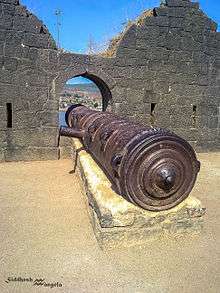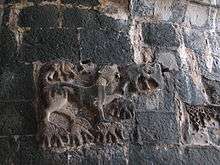Murud-Janjira
| Murud-Janjira | |
|---|---|
| मुरुड जंजिरा | |
| Raigad district, Maharashtra | |
 Murud Janjira panoramic view | |
 View inside Murud Janjira | |
 Murud-Janjira | |
| Coordinates | 18°17′59″N 72°57′51″E / 18.299773°N 72.964239°ECoordinates: 18°17′59″N 72°57′51″E / 18.299773°N 72.964239°E |
| Type | Island fort |
| Site information | |
| Owner | Government of India |
| Controlled by | Siddis |
| Open to the public | Yes |
| Condition | Partially intact |
| Site history | |
| Materials | Stone |
Murud-Janjira (![]() pron. ) is the local name for a fort situated on an island just off the coastal village of Murud, in the Raigad district of Maharashtra, India.[1]
pron. ) is the local name for a fort situated on an island just off the coastal village of Murud, in the Raigad district of Maharashtra, India.[1]
Origins of the name

The word Janjira is not native to India, and may have originated after the Arabic word Jazeera, which means an island. Murud was once known in Marathi as Habsan ("of Habshi" or Abyssinian). The name of the fort is a concatenation of the Konkani and Arabic words for Island, "morod" and "jazeera". The word "morod" is peculiar to Konkani and is absent in Marathi.[2]
Major features


Murud-Janjira Fort is situated on an oval-shaped rock off the Arabian Sea coast near the port town of Murud, 165 km (103 mi) south of Mumbai. Janjira is considered one of the strongest marine forts in India. The fort is approached by sailboats from Rajapuri jetty.
The main gate of the fort faces Rajapuri on the shore and can be seen only when one is about 40 feet (12 m) away from it. It has a small postern gate towards the open sea for escape.
The fort has 26 rounded bastions, still intact. There are many cannons of native and European make rusting on the bastions. Now in ruins, the fort in its heyday was a full-fledged living fort with all the necessary facilities, e.g., palaces, quarters for officers, mosque, two small 60-foot-deep (18 m) natural fresh water lakes, etc.[3] On the outer wall flanking the main gate, there is a sculpture depicting a tiger-like beast clasping elephants in its claws.

The palace of the Nawabs of Janjira at Murud is still in good shape.
A special attraction of this fort are 3 gigantic cannons named Kalalbangdi, Chavri and Landa Kasam. These cannons were said to be feared for their shooting range.[4] Another gate to the west is sea-facing, called 'Darya Darwaza'.
There is also another fortress, named Ghosalgad, which is located on top of the hill around 32 km (20 mi) east of Murud-Janjira, that was used as outpost for the rulers of Janjira.[5]
History

The Fort of Janjira on the sea is the only one of its kind. Janjira Jal-Durg (Sea Fort) was constructed by Malik Ambar, an Abssynian minister in the service of the Sultan of Ahmednagar, who belonged to the famous Nizamshahi dynasty. The fort, built at the end of the 17th Century, is almost entirely intact even today, despite the ravages of wind and tide, a testimony to the marvels of ancient engineering.
During its peak of glory the island fort boasted of having 572 cannons[6]
According to all accounts, the sea fort of Janjira could not be conquered by any of the kings ruling the neighboring territories. Surprisingly, not even Shivaji could acquire it despite 13 expeditions to conquer the fort. His son, Sambhaji, tried a unique approach to capture the fort: digging an underwater tunnel to enter. But he too failed in his attempt. Not to be deterred, Sambhaji constructed another fort just across the bay, called Kasa. Most of the earth that was dug up to build the tunnel was used in the making of this second fort, which was to be the base for future attacks on the sea fort of Janjira. This fort took 22 years to build and is constructed on 22 acres of land.
In a journey back in history, visitors can gain access to the Janjira fort from Rajapuri, a small village on the coast. After a short ride in a small boat, one can enter the fort through the main entrance. The fort is oval shaped instead of the usual oblong or square shape. The fort wall is about 40 feet high and has 19 rounded porches or arches, some of which still have cannons mounted on them, including the famous cannon Kalaal Baangadi. These cannons were largely responsible for repelling oncoming enemies from the sea. Inside the fort walls, the ruins of a mosque, a palace and bath with water channeled from streams, tell of ancient times when royal ladies occupied the quarters. The deep well with cold and sweet water - a wonder of nature in the midst of the saline sea, still provides water to quench the thirst of the weary visitor.
Gazing into the horizon from the ramparts of this magnificent fort overlooking the sea, one cannot but acknowledge its great strength that withstood a number of invasions. This invincible fort remained unconquered until it became part of Indian territory after Independence from the British in 1947.
On shore is a related attraction for history buffs, the Palace of the Nawab. This luxurious cliff-top mansion built by the former Nawab of Janjira commands a panoramic view of the Arabian sea and the Janjira sea fort.
However, according to another record has written that the Abyssinian Sidis had established the Janjira and Jafarabad state since early 1100.[7]
According to accounts written by the Portuguese Admiral Fernão Mendes Pinto, the Ottoman Empire fleet that first arrived in Aceh prior to Ottoman expedition to Aceh led by Kurtoğlu Hızır Reis has included 200 Malabar sailors from Janjira to aid the region Batak and the Maritime Southeast Asia in 1539.[8] Onwards in 1621, the Siddis of Janjira became exceptionally powerful as autonomous state to the point that the commander of Janjira, Siddi Ambar the little successfully defied his overlord, Malik Ambar attempt to replace him with a new commandant of Janjira fort. Siddi Ambar the little is accordingly considered as first Nawab of Janjira state.[9]
The island fortress was under control of Adil Shahi dynasty until the reign of Ibrahim II where Janjira fort was lost to the Siddis.[10]
Major historical figures from Murud-Janjira include men such as Sidi Hilal, Yahya Saleh and Sidi Yaqub. During the rule of Sultan Aurangzeb, Sidi Yaqut has received a subsidy of Rs. 400.000. He also owned large ships which weighed between 300 to 400 Tons. According to the record these ships were unsuitable for fighting on open sea against European warships, but it sizes allowed to transport soldiers for conducting the amphibious operations.[11]
Despite their repeated attempts, the Portuguese, the British and the Marathas failed to subdue the power of the Siddi's, who were themselves allied with the Mughal Empire. As example were when 10.000 soldiers of Moro Pandit assault were repulsed by Janjira army in 1676.[12] The Marathas led by Shivaji attempted to scale the 12-meter-high (39 ft) granite walls; he failed in all his attempts. His son Sambhaji even attempted to tunnel his way into the fort but was unsuccessful in all his attempts.[13] He built another sea fort in 1676, known as Padmadurg or Kasa fort, to challenge Janjira. It is located northeast of Janjira.


In the year 1736, Siddis of Murud-Janjira set out in a battle with the forces of Maratha Peshwa Baji Rao. On 19 April 1736, Maratha warrior Chimaji Appa attacked the gathering forces in the encampments of the Siddis near Rewas.[14] When the confrontation ended, 1,500 Siddi's, including their leader Siddi Sat, were killed. Peace was concluded in September 1736, but the Siddis were confined to only Janjira, Gowalkot, and Anjanwel, thus their power greatly reduced.
See also
- Murud, Raigad
- List of Indian Princely States
- List of forts in Maharashtra
- Khokari Tombs
- Janjira State
- Jafarabad State
- Maratha Navy
Sources
- Imperial Gazetteer of India, 2. A., 26 Bde., Oxford 1908–1931
- Malleson, G. B.: An historical sketch of the native states of India, London 1875, Reprint Delhi 1984
- Schwartzberg, Joseph E., Hrsg.: A historical atlas of South Asia, 2. A., New York/Oxford 1992, ISBN 0-19-506869-6
- http://www.maharashtratourism.gov.in/MTDC/HTML/MaharashtraTourism/TouristDelight/Forts/Forts.aspx?strpage=Murud_JanjiraForts.html Maharashtra - Murud Janjira Forts Official Govt. Page
References
| Wikimedia Commons has media related to Murud-Janjira. |
- ↑ Hoiberg, Dale; Indu Ramchandani (2000). Students' Britannica India. Popular Prakashan. p. 403. ISBN 0-85229-762-9. Retrieved 2009-03-17.
- ↑ Richard, M. Eaton (2005). A Social History of the Deccan, 1300-1761: Eight Indian Lives, Volume 1 1], [“The” new Cambridge history of India A Social History of the Deccan, 1300-1761: Eight Indian Lives, Richard Maxwell Eaton. Cambridge University Press. p. 127. ISBN 0521254841. Retrieved 30 October 2015.
- ↑ http://murudjanjira.blogspot.in/
- ↑ Gunaji, Milind (2003). Offbeat Tracks in Maharashtra. Popular Prakashan. p. 23. ISBN 8171546692.
- ↑ Gunaji, Milind (2010). Offbeat Tracks in Maharashtra. Popular Prakashan. p. 20 of 260. ISBN 8179915786. Retrieved 30 October 2015.
- ↑ Verma, Bharat. Indian Defence Review, Volume 24 (illustrated ed.). Lancer Publishers, 2010. pp. 49,156. ISBN 8170621720.
- ↑ Boyce, Carole Elizabeth (2008). Encyclopedia of the African Diaspora: Origins, Experiences, and Culture [3 volumes]: Origins, Experiences, and Culture. ABC-CLIO. p. 106. ISBN 1851097058.
- ↑ Cambridge illustrated atlas, warfare: Renaissance to revolution, 1492–1792 by Jeremy Black. p.17
- ↑ Hawley, John C. (Jun 25, 2008). India in Africa, Africa in India: Indian Ocean Cosmopolitanisms. Indiana University Press. pp. 255–256. ISBN 0253003164.
- ↑ Ahmed, Farooqui Salma (2011). A Comprehensive History of Medieval India: Twelfth to the Mid-Eighteenth Century. Pearson Education India. p. 176. ISBN 8131732029.
- ↑ Roy, Kaushik (30 Mar 2011). War, Culture and Society in Early Modern South Asia, 1740-1849 (Volume 3 Asian States and Empires ed.). Taylor & Francis. p. 13. ISBN 9781136790874. Retrieved 15 Jan 2016.
- ↑ Kyd Nairne, Alexander (1894). History of the Konkan (Reprint ed.). Asian Educational Services. p. 71 of 131. ISBN 8120602757. Retrieved 29 October 2015.
- ↑ India, Lonely Planet.
- ↑ Advance Study in the History of Modern India (Volume-1: 1707-1803) By G.S.Chhabra